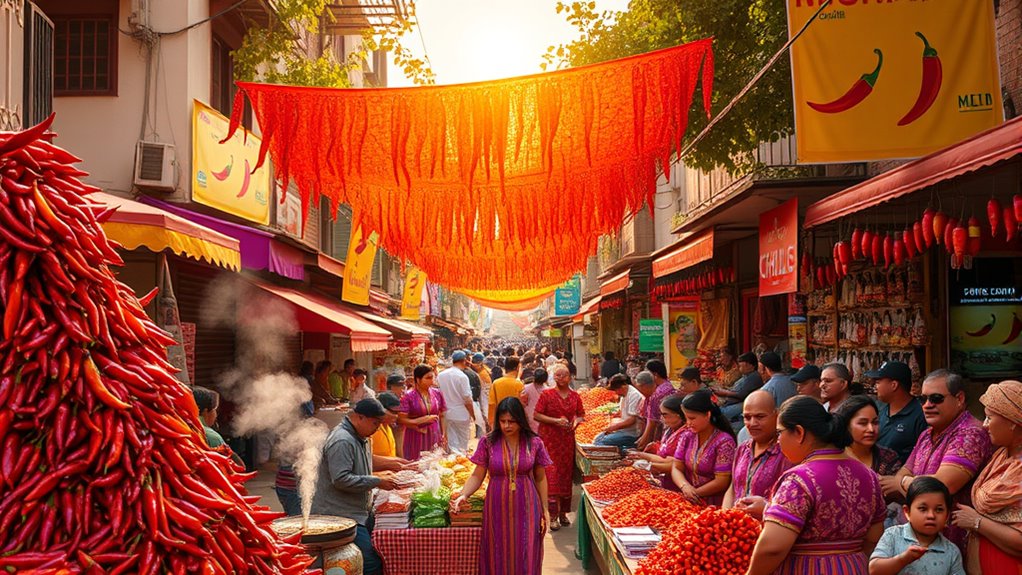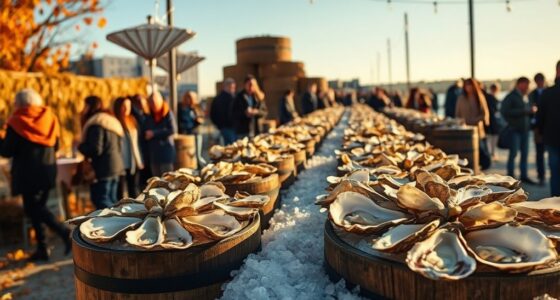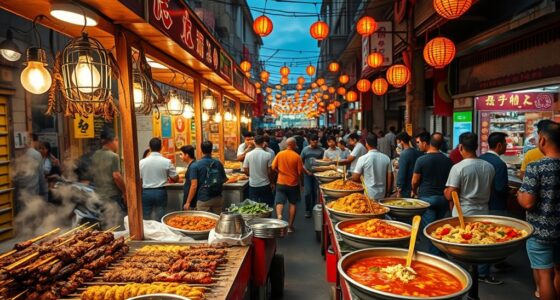Chili festivals worldwide celebrate the fiery passion of regional cuisines, bringing communities together through vibrant traditions, colorful displays, and spicy competitions. From Mexico’s festivals honoring local flavors to Texas’s cook-offs and France’s Basque-inspired events, each showcases unique chili varieties, culture, and entertainment. These lively gatherings boost local economies and preserve cultural heritage, all fueled by the shared love of heat and flavor. Explore more to discover the fiery stories behind each spicy celebration.
Key Takeaways
- Chili festivals worldwide celebrate cultural heritage, showcasing regional flavors, traditions, and community engagement through vibrant events.
- Notable festivals include Spain’s Pimientos de Padrón Fiesta, Texas’s Terlingua Cook-Off, and France’s Piment d’Espelette Festival.
- Events feature cooking competitions, chili art displays, live entertainment, and spicy tasting experiences for all ages.
- Regional chili varieties and hybrids reflect local climates, culinary customs, and agricultural innovation.
- Festivals promote sustainable farming, boost local economies, and strengthen community pride and cultural identity.
Celebrating the Global Passion for Chili

Across the world, people celebrate their love for chili through vibrant festivals that showcase its cultural significance and fiery flavors. These celebrations often highlight chili farming’s essential role, emphasizing local traditions and agricultural practices. You’ll see communities coming together to honor chili trade, which connects farmers to markets and fuels regional economies. In countries like Mexico and India, chili festivals are deeply rooted in history, attracting visitors enthusiastic to taste spicy dishes and learn about chili’s journey from field to table. Such events foster pride in local varieties and promote sustainable farming. As chili’s popularity grows globally, these festivals serve as lively platforms to share culinary heritage, boost trade, and ignite passion for this fiery crop that unites diverse cultures through shared spice. Additionally, many festivals incorporate sustainable farming practices, encouraging farmers to adopt environmentally friendly methods that protect soil health and reduce chemical usage.
Notable Festivals and Their Unique Features

Notable chili festivals around the world each showcase their unique traditions and flavors, drawing visitors enthusiastic to experience local culture and spicy cuisine. At the Piment d’Espelette Festival in France, you’ll see stunning chili art, traditional folk music, and vibrant festival fashion that reflect Basque heritage. In Texas, the Terlingua Cook-Off offers a rugged desert setting where participants compete in fiery chili recipes and enjoy a lively, community-driven atmosphere. The Hot Sauce & Fiery Foods Festival showcases innovative hot sauces, spicy snacks, and culinary demonstrations, perfect for spice lovers and hot sauce enthusiasts. Meanwhile, Spain’s Pimientos de Padrón Fiesta surprises you with the unpredictable heat of tiny peppers, often paired with local wines, celebrating regional gastronomy and playful “heat lottery” fun. These festivals often feature live cooking demonstrations and competitions, attracting culinary enthusiasts eager to learn spicy recipes and techniques from local chefs. Additionally, many of these events highlight cultural significance, emphasizing the importance of chili peppers in regional traditions and cuisine.
The Thrill of Chili Eating Contests

Chili festivals aren’t just about tasting spicy dishes—they also feature intense eating contests that thrill spectators and participants alike. In these competitions, chili eating tests your heat tolerance and speed, pushing limits with massive quantities and fiery peppers. Top competitors like Carmen Cincotti and Joey Chestnut have set records, consuming over two gallons of chili in minutes. Some contests challenge heat tolerance with Carolina Reaper chilis, where speed and pain endurance matter most. These events often follow strict rules: fixed time frames, standardized bowls, and safety measures. Whether it’s volume or heat, participants face oral and gastrointestinal challenges that demand stamina and focus. These contests are governed by official rules to ensure fairness and safety. Ensuring proper safety protocols is crucial to prevent health issues during these intense competitions. Here’s a quick overview:
| Aspect | Key Feature | Notable Record |
|---|---|---|
| Quantity | Fast eating, volume | Carmen Cincotti: 9.22 liters in 6 min |
| Heat Tolerance | Spicy chili consumption | Mike Jack: 50 Carolina Reapers in 6 min |
| Rules & Safety | Standardized bowls, measures | Fairness, health precautions |
Regional Flavors and Cultural Traditions

As you explore chili festivals, you’ll notice how regional varieties and local culinary traditions shape the celebrations. Unique chili types, like the spicy peppers of southern Chile or the milder options on Easter Island, influence the dishes and rituals. These festivals often feature customs and ceremonies that reflect their cultural heritage, creating a vibrant tapestry of flavors and traditions. Chile’s diverse climate allows for a wide range of chili cultivations, further enriching the variety of festival experiences across different regions. Additionally, the influence of AI in retail success has enabled organizers to better understand attendee preferences, enhancing the overall festival experience.
Unique Chili Varieties
Around the world, unique chili varieties reflect diverse regional flavors and cultural traditions. You’ll find rare hybrids and colorful cultivars that tell stories of local heritage and innovation. Imagine biting into a Chocolate Ghorpion, with its dark, wrinkled pods and fiery heat, or savoring the grapefruit-scented Moruga Red Satan, reaching up to 2 million SHU. In the U.S., the Carolina Reaper and Apollo Pepper push spice boundaries, while Indian hybrids like Bhut Jolokia and Chocolate Ghorpion showcase superhot extremes. These chilies aren’t just about heat—they symbolize cultural pride and regional ingenuity. Chocolate Ghorpion originates from India, discovered in 2020, and is a hybrid of the Bhut Jolokia and Butch T Trinidad Scorpion, measuring approximately 2.2 million SHU on the Scoville Scale. Feel the thrill of extreme heat from rare hybrids like Carolina Reaper. Admire the vivid hues of colorful cultivars like Peachgum Tiger. Experience the fierce intensity of Indian superhot peppers. Celebrate regional traditions through these fiery, unique varieties and appreciate the significance of regional culinary heritage.
Culinary Traditions Expressed
Culinary traditions during chili festivals vividly showcase regional flavors and cultural identities. You’ll see chili cultivation play a key role, with communities celebrating native chili varieties through dishes that highlight local ingredients like corn, cherries, and seafood. Preservation methods are just as important, with drying and making chili sauces reflecting traditional techniques passed down generations. Indigenous influences, especially from the Mapuche, infuse recipes with native herbs and cooking styles, such as open fire grilling. Regional flavors adapt to local produce, with coastal areas emphasizing seafood and interior regions focusing on meats. These culinary practices serve as a living link to ancestral customs, honoring seasonal cycles and agricultural calendars. Chili cultivation is often intertwined with local festivals, reinforcing community bonds and cultural identity. Festivals become a vibrant stage for expressing cultural resilience through the art of chili cultivation and preservation, supported by traditional farming methods that sustain these rich culinary heritages.
Festival Customs and Rituals
Festival customs and rituals centered on regional flavors and cultural traditions bring communities together to celebrate their unique chili heritage. You’ll witness vibrant chili roasting, where locals connect with sustainable farming practices and honor tradition. In places like Hatch Valley, large-scale verde sauce production showcases chili art, blending culinary skill with cultural pride. Smaller Sichuan pepper festivals highlight preserved vegetables and regional crafts, emphasizing local identity. In Rioja, native piquant peppers intertwine with wine traditions, creating hybrid celebrations. Community events often feature chili eating contests, cooking demos, and lively parades that reflect local heritage. These festivals often incorporate traditional music and dance, further enriching the cultural experience. Additionally, some festivals incorporate educational workshops to teach visitors about sustainable harvesting methods and regional cultivation techniques. – Savor chili art through colorful displays and carvings – Participate in hot sauce competitions that unite neighbors – Engage in traditional rituals rooted in harvest cycles – Experience lively parades blending culture and culinary pride
Activities That Spice Up the Festivities
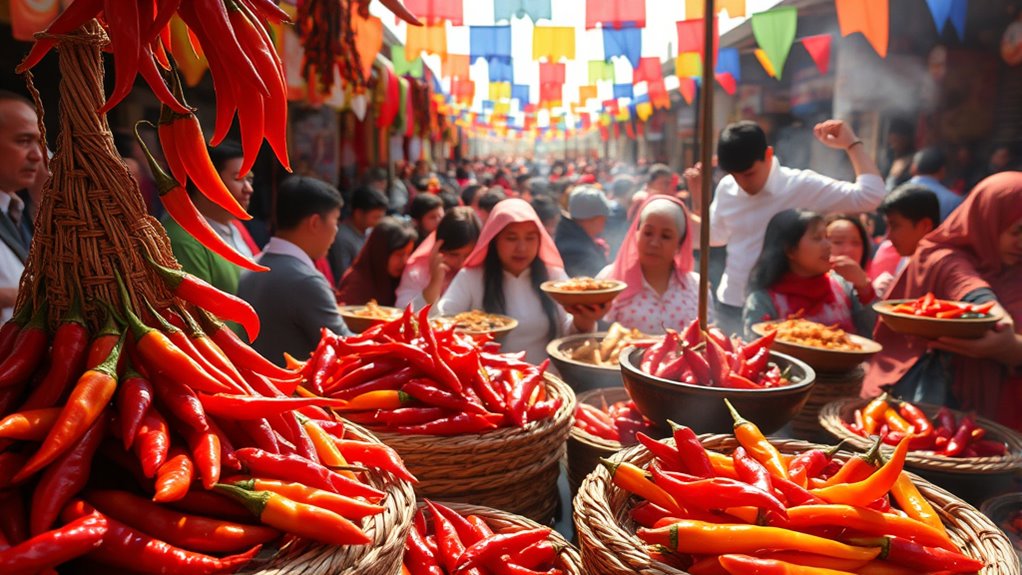
At chili festivals, you’ll find plenty of exciting activities to get your heart racing. Tasting spicy delights and competing in hot sauce challenges let you experience the heat firsthand, while live entertainment keeps the energy high. These lively events turn up the fun and make each festival unforgettable. Exploring diverse genres of spicy foods can also introduce you to new flavors and cooking styles.
Tasting Spicy Delights
If you love exploring bold flavors, tasting spicy delights at chili festivals is an experience you won’t forget. As you wander through tasting booths, you’ll encounter a vibrant spectrum of chili varieties—from mild to fiery. Some stalls showcase regional chili art, revealing the cultural stories behind each spice, while others tell spicy storytelling through traditional recipes and innovative chili-infused foods. You might savor hot sauces, traditional dishes, or sample chili pairings with local drinks.
- Savor unique regional flavors like Thai-inspired Chaiyo Chili or Indian Naga chili
- Participate in guided tasting sessions and vote for your favorites
- Discover new chili art displays that celebrate cultural spice traditions
- Engage in spicy storytelling, learning about chili’s history and significance
Enjoying these festivities also offers a chance to learn about the cultural significance of chili in different regions, enriching your spicy adventure.
This sensory journey will deepen your appreciation for the fiery world of chili festivals.
Cooking Competitions Showcases
Cooking competitions are the heart of chili festivals, turning up the excitement with fiery showdowns that showcase culinary skill and creativity. These events highlight chili ingredient innovations, encouraging cooks to experiment with unique flavors and sustainable ingredients, which helps promote festival sustainability. Major contests like the World Championship Chili Cook-off and Terlingua attract top chefs, including youth divisions that inspire the next generation of chili enthusiasts. Judging focuses on flavor, aroma, texture, and originality, often rewarding showmanship and presentation. Live demonstrations and culinary challenges add to the energy, while charity components and community engagement deepen the festival’s impact. By fostering innovation and sustainable practices, these competitions keep chili festivals vibrant, meaningful, and memorable for everyone involved. Sustainable practices also play a crucial role in ensuring the longevity and ecological responsibility of these lively events.
Live Entertainment Acts
Ever wonder how chili festivals turn up the excitement beyond the spicy dishes? It’s all about the live entertainment acts that energize the crowd. You can enjoy chili themed dance performances that showcase vibrant traditional costumes and lively rhythms, creating a colorful spectacle. Live music collaborations bring regional bands and talented artists together, filling the air with energetic tunes that keep everyone dancing. These performances:
- Elevate the festive atmosphere with dynamic dance shows
- Create memorable moments through live music collaborations
- Engage families and tourists with cultural displays
- Encourage extended visits and social interaction
- Themed costumes and costume accessories add visual excitement to the festivities
Paired with food trucks and vendors, these acts transform the festival into a sensory feast for the ears and eyes, making every moment truly unforgettable.
The Economic and Cultural Impact of Chili Events
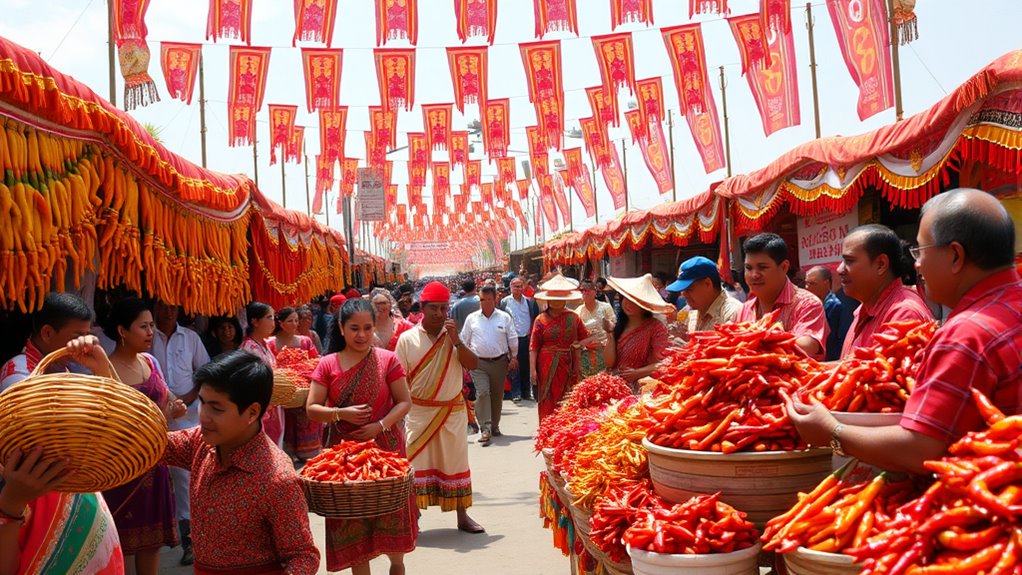
Chili festivals have a significant impact on both local economies and cultural identity, drawing thousands of visitors who boost spending and support businesses. These events promote economic sustainability by increasing tourism-related revenue, with festivals like Pueblo’s attracting out-of-town visitors from across the region, generating over $103 million in economic influence. They also expand regional tourism reach, benefiting local vendors and farmers. Additionally, chili festivals help preserve cultural traditions and strengthen community bonds, reinforcing regional pride and culinary heritage. By showcasing local agricultural products, especially Pueblo Chile, these festivals enhance brand awareness and sustain demand for local farmers. Understanding store hours can help visitors plan their trips more effectively, ensuring they do not miss key events or opportunities. Overall, chili festivals serve as essential platforms for economic growth and cultural preservation, ensuring that regional traditions flourish while supporting long-term community prosperity.
Emerging Trends and Future of Chili Festivals
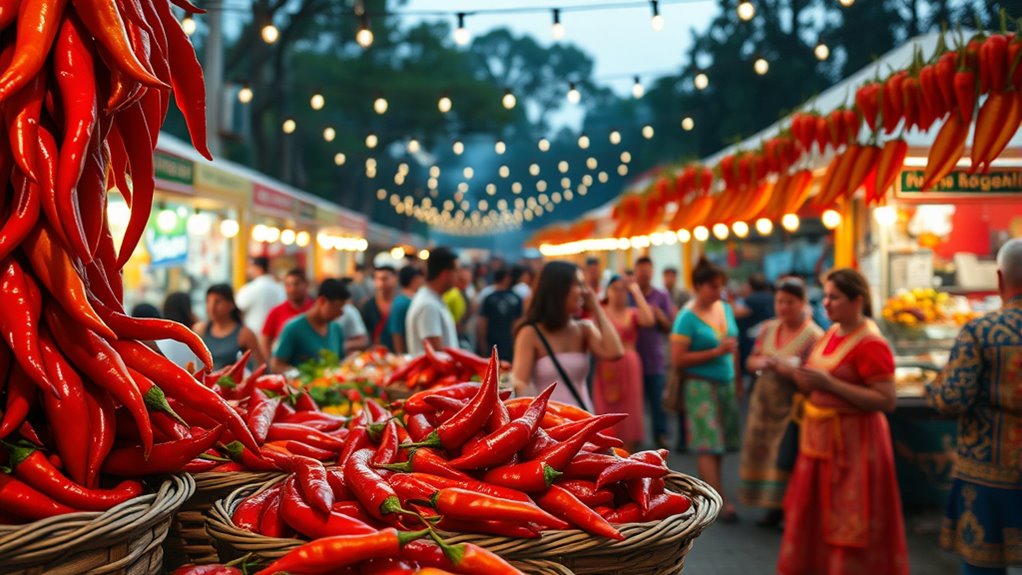
The future of chili festivals is increasingly shaped by technological innovations that enhance attendee experiences and expand global reach. Virtual innovation allows you to participate from anywhere via live streaming, virtual tasting kits, and online forums, making these events more accessible. Interactive AR features create immersive chili tasting and cooking demos, heightening your engagement. Cashless payments streamline your purchases, reducing wait times, while personalized digital platforms tailor experiences to your preferences. Plus, environmental sustainability remains central, with zero-waste policies, eco-friendly sourcing, reusable utensils, and carbon offset programs. These efforts ensure festivals grow responsibly, emphasizing community and ecological health. Additionally, storage and preservation techniques are vital for maintaining the quality and safety of chili festival ingredients and products.
- Feel connected worldwide through live streams and online communities
- Experience immersive tasting and cooking demos from your home
- Support sustainable practices that protect chili farming and the environment
- Enjoy a more inclusive, eco-conscious festival future
Frequently Asked Questions
What Are the Longest-Running Chili Festivals Worldwide?
You’re curious about the longest-running chili festivals worldwide. These festivals often have rich chili history and deep roots in festival origins, dating back over 50 years. The Oldest in the U.S., like the Terlingua International Championship Chili Cookoff since 1967, highlights long-standing traditions. Many global festivals, built on community and competition, continue to celebrate chili’s cultural significance, blending culinary skill with local customs and evolving entertainment to preserve their longevity.
How Do Chili Festivals Promote Local Agriculture and Farming?
Chili festivals promote local agriculture by showcasing unique local crop varieties and farming traditions, which encourages community pride and cultural preservation. As a visitor, you help farmers gain recognition and boost demand for their produce, leading to increased income. These festivals also educate audiences about sustainable practices, motivating farmers to maintain traditional methods. By supporting these events, you’re directly contributing to the longevity and robustness of local farming communities.
What Safety Measures Are in Place During Chili Eating Contests?
You face a fiery challenge, but spicy safety is top priority. Contest precautions include strict hygiene protocols like handwashing and hair restraints, ensuring no contamination. Only cooks serve the chili with sanitary tools, and temperatures are carefully monitored. Participants must stay seated, avoid spitting or vomiting, and consume every bit of chili. Emergency measures are ready, with medical staff on standby, making sure everyone’s fiery adventure stays safe and controlled.
How Do Festivals Cater to Different Cultural Perceptions of Spice?
You see, festivals cater to different cultural perceptions of spice by respecting cultural sensitivities and highlighting spice symbolism. They incorporate traditional ingredients and dishes that resonate locally, ensuring authenticity. You’ll find events that celebrate spices’ cultural significance, like turmeric in Indian festivals or chili peppers in Mexican celebrations. This approach fosters cross-cultural understanding, allowing attendees to appreciate each culture’s unique spice traditions while honoring their historical and symbolic meanings.
What Are the Environmental Impacts of Large-Scale Chili Festivals?
Imagine the vibrant colors and smoky aroma filling the air at a chili festival, but behind that excitement, large crowds strain local resources. You can see the impact in waste piles and increased emissions from travel and setup. To minimize this, adopting sustainable practices and effective waste management is key. You can help by encouraging eco-friendly transportation, recycling efforts, and reducing single-use plastics, making the event more environmentally friendly.
Conclusion
As you explore these fiery festivals, you’ll find they’re more than just heat—they’re a vibrant tapestry woven with culture, community, and passion. Each event adds a splash of color to the global palette of traditions, proving that chili’s true spice lies in uniting people across borders. So, next time you taste that blazing bite, remember you’re part of a worldwide celebration where the flame of flavor keeps burning bright, lighting up hearts and horizons alike.
